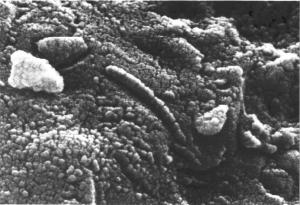This microscopic image of a meteorite from Mars shows tube-like structures. In 1996, NASA scientists announced that these structures could have been formed by microscopic organisms. It was one of several pieces of evidence that led them to conclude that the rock held evidence of ancient Martian life. Many other scientists have since refuted much of the study's evidence, concluding the rock was bereft of life. Some of the study team's original members stand by their original conclusions. [NASA]
You are here
ALH 84001
A trio of rovers is looking for evidence of life on the Red Planet — past or present. One of them is even gathering samples that might one day be returned to Earth by a follow-up mission. That would give scientists a chance to study the samples with the most advanced technologies on Earth.
In the 1990s, scientists studied a Mars rock with the most advanced technologies of the time. And 25 years ago this week, they reported finding evidence of life.
The rock was a Mars meteorite. It formed more than four billion years ago, when lava on Mars cooled and solidified. It was blasted into space about 16 million years ago when an asteroid slammed into Mars. The rock fell to Earth in Antarctica 13 thousand years ago. It was discovered in the Allan Hills in 1984, so it was named ALH 84001.
Scientists discovered that it came from Mars by measuring tiny air bubbles in the rock. Gases in the bubbles match those in the Martian atmosphere.
NASA scientists spent years analyzing tiny fragments of the rock. A combination of several findings hinted that the rock held evidence of ancient microscopic life — a stunning discovery.
Soon, though, other scientists looked at pieces of ALH84001 as well. Most of them concluded that the evidence of life had been produced by chemical or geological processes — not by Martian “bugs.” Yet the debate about the meteorite continues; more about that tomorrow.
Script by Damond Benningfield
Get Premium Audio
Listen to today's episode of StarDate on the web the same day it airs in high-quality streaming audio without any extra ads or announcements. Choose a $8 one-month pass, or listen every day for a year for just $30.






